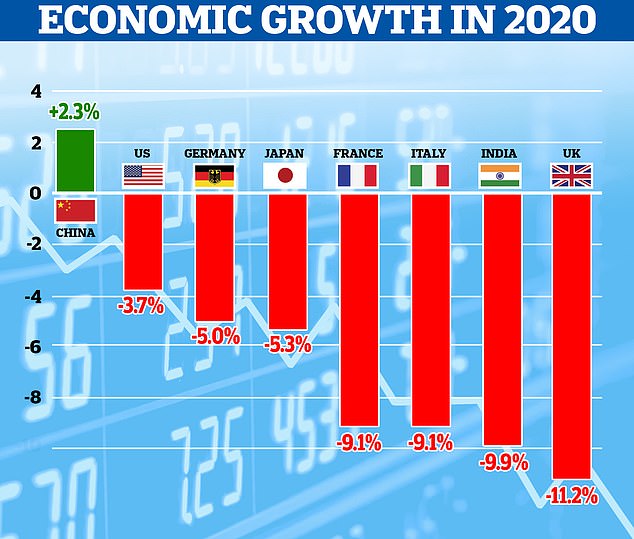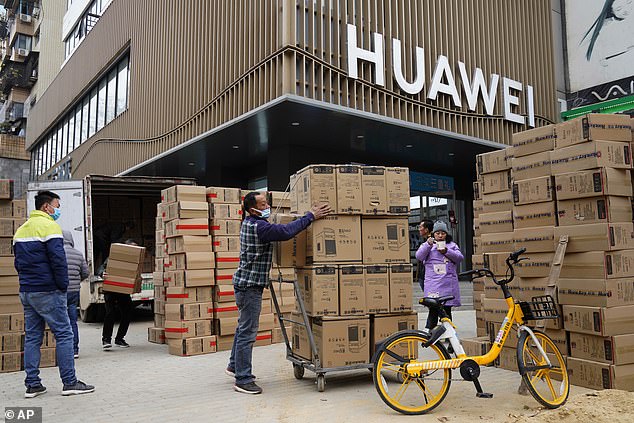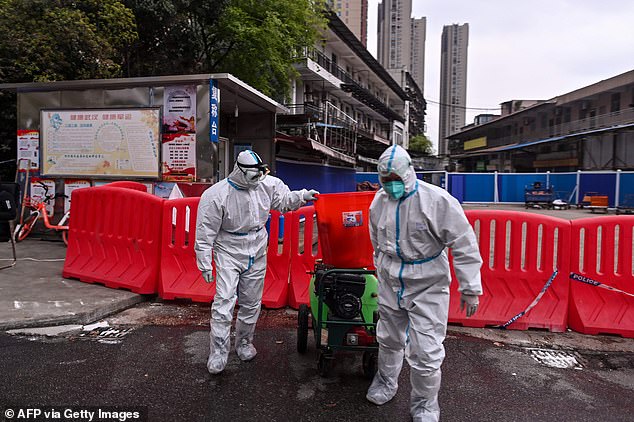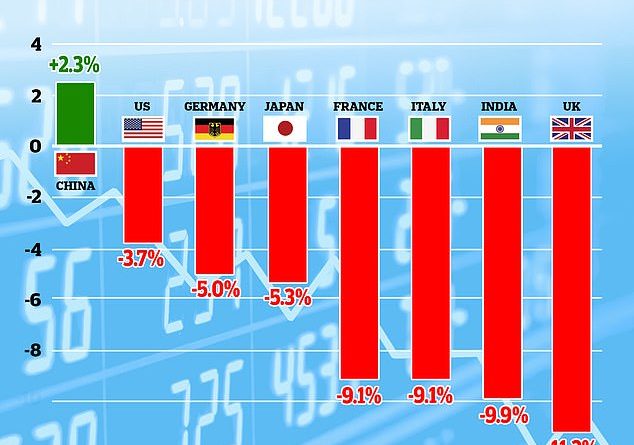China was the only major economy to grow in 2020
China’s economy grew by 2.3 per cent in 2020, official figures revealed today, making it the only major economy to grow at all during the year of the coronavirus.
The 2.3 per cent expansion was better than experts had predicted and came after China’s economy bounced back from the pandemic by exporting medical equipment and seizing market share from struggling rivals.
While much of the world economy is still hampered by resurgent virus outbreaks and resulting strict lockdowns, Beijing claims to have largely brought the virus under control within its own borders following the initial outbreak in Wuhan a year ago.
Every other OECD country is expected to publish figures showing an economic decline in 2020, with projected recessions of 3.7 per cent in the US, 7.5 per cent in the eurozone and 11.2 per cent in the UK.

China’s GDP grew by 2.3 per cent in 2020, making it the only major economy likely to record economic growth in the year of the pandemic. German officials announced a 5.0 per cent recession last week, while OECD projections are shown for other major economies
China’s figures show a marked slowdown from the 6.0 per cent growth in 2019, which was already the lowest in decades amid trade tensions and weak domestic demand.
The full-year growth of 2.3 per cent was the Chinese economy’s worst performance since a 1.6 per cent contraction in 1976, the year that Mao Zedong died.
The National Bureau of Statistics (NBS) said last year was a ‘grave and complex environment both at home and abroad’ with the pandemic having a ‘huge impact’.
But the figures are better than those forecast by an AFP poll of analysts from 13 financial institutions, who had predicted a 2.0 percent expansion.
The overall growth included a 6.5 per cent rebound in the last three months of 2020, bringing it back to a pre-pandemic trajectory.
By contrast, the world economy was projected by the OECD to shrink by 4.2 per cent in 2020, with larger slumps in Britain, Italy, France and India among others.
Industrial production grew by 2.8 per cent year on year after factories swiftly re-opened following the initial lockdowns last winter.
But retail sales shrank by 3.9 per cent for the full year, the first contraction since 1968, with consumers wary of spending as the pandemic lingered.
NBS commissioner Ning Jizhe told reporters the foundation for China’s economic recovery ‘is still not yet firm’.
‘There are many uncertainties in the changing dynamics of the pandemic, as well as the external environment,’ he said.
The urban unemployment rate remained at 5.2 per cent, and Ning said the number of newly-employed in urban areas was more than 11 million – exceeding the target of nine million.
However, experts have cautioned unemployment could be higher than official figures suggest due to the large numbers of people in China’s informal workforce.
‘The strengthening momentum of China’s economic rebound during the fourth quarter of 2020 reflected improving private consumption expenditure as well as buoyant net exports,’ said Rajiv Biswas, IHS Markit’s Asia-Pacific chief economist.
He added exports were helped by rebounding orders from the United States and Europe, including shipments of medical equipment during the pandemic.

Rebound: Workers move boxes of computers on a street in Wuhan on Saturday, after Chinese companies and exporters took advantage of the global economic standstill
Figures published last week showed China enjoying an 18 per cent export boom in December and seeing its trade surplus with America widen during 2020.
But Iris Pang, ING chief economist for Greater China, said ‘when China can achieve a complete recovery is still an open question’, given that without fiscal and monetary stimulus, the economy would not have recovered at such a pace.
She added: ‘The risk of a technology war between China and some economies remains if the US does not remove some measures.’
New government restrictions due to local Covid-19 outbreaks could also hamper first quarter growth this year, said Louis Kuijs of Oxford Economics.
China’s strong export figures saw its politically volatile trade surplus rise to $535billion, one of the highest ever reported – with a 7.1 per cent rise in its surplus with America.
Exports to the US rose by 7.9 per cent despite tariff hikes on most Chinese goods by the Trump administration, which has been at loggerheads with Beijing over a long list of issues.
The figures show that China’s trade surplus with America has widened by 15 per cent since Trump took office in 2017.
Even with Trump leaving office this week, analysts expect few changes in the US-China relationship due to widespread frustration in Washington with China’s record on trade, human rights and technology theft.

2020: Health workers wearing white hazmat suits work near the Huanan Seafood Wholesale Market in Wuhan which has been linked to the early spread of the coronavirus
On Friday, the US state department released a ‘fact sheet’ claiming that researchers at the Wuhan Institute of Virology had been sick with possible Covid-19 symptoms before the outbreak first came to light in December 2019.
China has rejected claims that the virus could have leaked from the lab, and has touted unproven theories that it might have originated in Europe or elsewhere.
Several countries have found evidence that the virus had already reached them in the final months of 2019.
But it was not until December 31, 2019 that the WHO’s China office was informed of a mystery pneumonia which had sickened 44 people in Wuhan.
Later, the WHO was informed that at least one patient in Wuhan – a major transport hub – had been showing symptoms as early as December 8.
China has always denied allegations of a cover-up, reacting angrily to calls for an international investigation into the origins of the virus.
Last week it allowed a team of WHO experts to enter the country on a politically sensitive mission but they were not expected to probe the lab leak theory.
Numerous reports have detailed how China withheld key details about the virus in its early stages, including from the WHO which has praised China in public.
A young doctor, Li Wenliang, was reprimanded by police after trying to raise the alarm about the disease – and later died of it.



